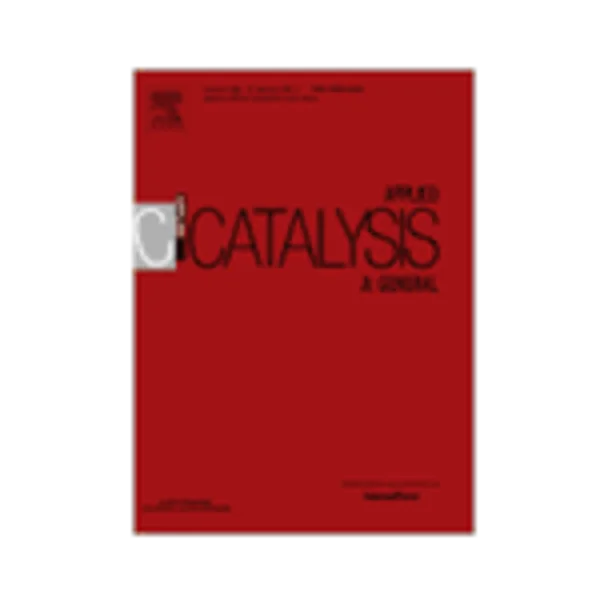-
wo3 monolayer loaded on zro2: property–activity relationship in n-butane isomerization evidenced by hydrogen adsorption and ir studies
جزئیات بیشتر مقاله- تاریخ ارائه: 1392/07/24
- تاریخ انتشار در تی پی بین: 1392/07/24
- تعداد بازدید: 919
- تعداد پرسش و پاسخ ها: 0
- شماره تماس دبیرخانه رویداد: -
wo3 monolayer loaded on zro2: property–activity relationship in n-butane isomerization evidenced by hydrogen adsorption and ir studiesthe property–activity relationship of wo3 supported on zro2 (wz) was evaluated in n-butane isomerization for a series of catalysts with wo3 loading ranging from 5 to 20 wt% on zro2. the catalysts were prepared by incipient-wetness impregnation of zr(oh)4 with an aqueous solution of (nh4)6[h2w12o40•nh2o], followed by drying and calcination at 1093 k. the introduction of wo3 continuously increased the tetragonal phase of zro2, wo3 surface density and coverage. the specific surface area and total pore volume passed through a maximum of wo3 loading at 13 wt%; this loading corresponds to 5.9 wo3/nm2 and is near the theoretical monolayer-dispersed limit of wo3 on zro2. the ir results indicate that the presence of wo3 eroded the absorbance bands at 3738 and 3650 cm−1 corresponding to bibridged and tribridged hydroxyl groups up to near the monolayer-dispersed limit of wo3. a new broad and weak band appeared, centered at 2930 cm−1, indicating the presence of bulk crystalline wo3 for wo3 coverage exceeding the theoretical monolayer-dispersion limit. in addition to the band at 2930 cm−1, two wo stretching bands were observed at about 1021 and 1014 cm−1 for all wz catalysts, confirming the existence of wo connected to coordinative unsaturated (cus) zr4+ through o and to the other w through o, respectively. pyridine adsorbed ir and nh3-tpd revealed that the presence of wo3 modified the nature and concentration of acidic sites. the highest acidity was observed with 13 wt% loading wo3. the decrease in the intensity of peaks due to increasing wo3 loading was much higher on lewis acid sites than on brønsted acid sites. hydrogen adsorption isotherms and the ir results for hydrogen adsorption on preadsorbed pyridine were used to evaluate the formation of active protonic acid sites from molecular hydrogen. the catalyst with 13 wt% wo3 loading showed the maximum hydrogen uptake capacity and formation of protonic acid sites.
مقالات جدیدترین رویدادها
-
استفاده از تحلیل اهمیت-عملکرد در ارائه الگوی مدیریت خلاقیت سازمانی و ارائه راهکار جهت بهبود
-
بررسی تاثیر ارزش وجوه نقد مازاد بر ساختار سرمایه شرکت های پذیرفته شده در بورس اوراق بهادار تهران
-
بررسی تأثیر سطح افشای ریسک بر قرارداد بدهی شرکت های پذیرفته شده در بورس اوراق بهادار تهران
-
بررسی تأثیر رتبه بندی اعتباری مبتنی بر مدل امتیاز بازار نوظهور بر نقد شوندگی سهام با تأکید بر خصوصی سازی شرکت ها
-
تأثیر آمیخته بازاریابی پوشاک ایرانی بر تصویر ذهنی مشتری پوشاک ایرانی (هاکوپیان)
-
بررسی تأثیر روش حل مسأله در تحقق اهداف دروس ابتدایی
-
پایه های شناختی تنظیم هیجانی در فاز مانیک و افسرده در بیماران دوقطبی و افراد سالم
-
اثربخشی شفقت درمانی مبتنی بر بخشش بر بهباشی زنان مطلقه
-
تاثیر بوروکراسی اداری بر اثربخشی سازمانی با میانجیگری فرهنگ سازمانی در ادارات بناب
-
determination of minocycline by rhodamine b-modified gold nanoparticles
مقالات جدیدترین ژورنال ها
-
مدیریت و بررسی افسردگی دانش آموزان دختر مقطع متوسطه دوم در دروان کرونا در شهرستان دزفول
-
مدیریت و بررسی خرد سیاسی در اندیشه ی فردوسی در ادب ایران
-
واکاوی و مدیریت توصیفی قلمدان(جاکلیدی)ضریح در موزه آستان قدس رضوی
-
بررسی تاثیر خلاقیت، دانش و انگیزه کارکنان بر پیشنهادات نوآورانه کارکنان ( مورد مطالعه: هتل های 3 و 4 ستاره استان کرمان)
-
بررسی تاثیر کیفیت سیستم های اطلاعاتی بر تصمیم گیری موفق در شرکتهای تولیدی استان اصفهان (مورد مطالعه: مدیران شرکتهای تولیدی استان اصفهان)
-
سبک زندگی اسلامی در همه گیری جهانی کرونا
-
تبیین اثر شایستگی سازمانی بر عملکرد شغلی کارکنان با نقش واسطه تسهیم دانش (مورد مطالعه: شعب بانک سینا در تهران)
-
تأثیر قابلیت نوآوری وتسهیم دانش بر عملکرد نوآوری وعملکرد بازاریابی (مورد مطالعه: بانک پارسیان استان تهران)
-
روند تغییر پرچم ایران از عصرصفوی تا دوران معاصر با بررسی عناصر رنگ، نشان و طراحی پرچم ایران
-
a comparison on psychological well-being in gifted and normal students




سوال خود را در مورد این مقاله مطرح نمایید :